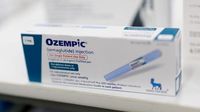Novo Nordisk has once again shaken up the pharmaceutical world with a milestone achievement: on August 20, 2025, the U.S. Food and Drug Administration (FDA) granted accelerated approval for its blockbuster drug Wegovy as a treatment for metabolic dysfunction-associated steatohepatitis (MASH). This marks the first time a GLP-1 receptor agonist has been authorized for this increasingly prevalent liver disease, and the decision is already reverberating across both medical and investment circles.
The approval of Wegovy for MASH is more than just another regulatory green light. According to a report from AInvest, it represents a major shift in the way chronic metabolic diseases are approached and managed. The ESSENCE clinical trial, which formed the backbone of the FDA’s decision, delivered results that have been described as both statistically significant and clinically transformative. In the trial, 62.9% of patients receiving Wegovy achieved resolution of steatohepatitis without worsening fibrosis, compared to only 34.3% on placebo. Additionally, 36.8% of patients on Wegovy experienced an improvement in liver fibrosis versus 22.4% in the placebo group. These numbers are not just impressive—they suggest a new standard of care for a disease that currently affects 15 million adults in the United States and is expected to impact 27 million by 2030.
The commercial implications of this development are enormous. Analysts cited by AInvest estimate that the MASH treatment market could be worth $30 billion, with Wegovy alone potentially capturing a $7.38 billion share by 2029. Novo Nordisk is projected to command 30–40% of this market, translating to $10–15 billion in annual revenue from Wegovy. As if that weren’t enough, peak MASH-related revenue for Wegovy is forecasted at $1.9 billion, adding to its already robust $10.8 billion in 2024 revenue from obesity and diabetes indications.
What sets Novo Nordisk apart in this race is its coveted first-mover advantage. While rivals like Eli Lilly’s tirzepatide and Madrigal Pharmaceuticals’ Rezdiffra are still making their way through the regulatory maze, Wegovy’s head start—estimated at 12 to 18 months—gives Novo Nordisk a precious window to establish dominance. This early entry is especially crucial in a field where physician trust and patient adherence can determine a drug’s long-term success.
Wegovy’s subcutaneous delivery model and high adherence rate of 83.5% (with over 10 million patients treated worldwide) make it a favorite among both doctors and patients. The drug’s safety profile is well-established, and its pricing—set at $1,300 per month—may seem steep but is softened by Novo Nordisk’s NovoCare co-pay assistance program and a series of partnerships with insurers. Notably, the company has already secured Medicare Part D coverage for Wegovy’s use in reducing cardiovascular risk, a move that could pave the way for expanded reimbursement in the MASH setting, where cost-effectiveness is a top concern for payers.
But Novo Nordisk isn’t resting on its laurels. Its research and development pipeline is bustling with next-generation therapies designed to cement its leadership in the GLP-1 class. Drugs like CagriSema (a dual GLP-1/amylin agonist) and Amycretin are already in late-stage trials, promising even better efficacy and fewer side effects—addressing some of the lingering limitations of current GLP-1 therapies. An oral formulation of semaglutide for obesity is also in the works, expected to hit the market in late 2025. This innovation could further broaden access and improve patient compliance, especially for those wary of injections.
Another factor that makes Novo Nordisk’s position so enviable is its patent fortress. With Wegovy’s patents extending through 2035, the company enjoys over a decade of insulation from generic competition—a rarity in the pharmaceutical industry. This exclusivity, coupled with ongoing global regulatory filings (including anticipated approvals in the European Union and Japan by 2026), ensures that Wegovy’s growth potential isn’t limited to the U.S. market.
It’s worth noting that while Madrigal’s Rezdiffra was technically the first drug approved for MASH in 2024, its oral formulation and gastrointestinal side effects have limited its appeal. Wegovy, by contrast, offers a unique value proposition: not only does it address liver disease, but it also delivers proven benefits for weight loss. This dual efficacy could sway both physicians and patients toward Novo Nordisk’s offering, especially as the burden of metabolic diseases continues to rise worldwide.
For investors, the story is equally compelling. Novo Nordisk’s ability to pivot Wegovy from a weight-loss powerhouse to a treatment for a serious liver disease demonstrates both agility and vision. According to AInvest, the company’s revenue forecast for Wegovy stands at $18.1 billion by 2030, with its other GLP-1 juggernaut, Ozempic, projected to reach $24.4 billion. The company’s focus on the broader metabolic disease market—a staggering $100 billion opportunity—offers a rare combination of near-term revenue growth and long-term innovation.
Of course, competition is heating up. Eli Lilly’s Zepbound and other GLP-1 drugs are entering the fray, and the landscape is likely to become even more crowded in the coming years. However, Novo Nordisk’s first-mover advantage, robust R&D pipeline, and global regulatory strategy provide a durable edge that’s hard to match. The company’s strategic approach—combining scientific breakthroughs with savvy market execution—has positioned it as a leader not just in the MASH space, but in the entire field of metabolic medicine.
Looking ahead, the stakes couldn’t be higher. With MASH projected to affect tens of millions of people in the coming years, and healthcare systems around the world grappling with the costs of chronic metabolic diseases, the demand for effective, accessible treatments is only going to grow. Novo Nordisk’s expanded approval for Wegovy is a clear sign that the company is ready to meet that challenge head-on.
As the dust settles on this latest regulatory milestone, one thing is clear: Novo Nordisk has not only redefined the therapeutic landscape for MASH but has also set a new standard for innovation and growth in the pharmaceutical industry. For patients, physicians, and investors alike, the future of metabolic disease treatment just got a lot more interesting.


